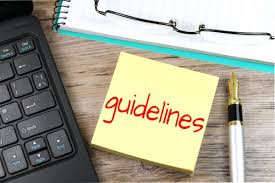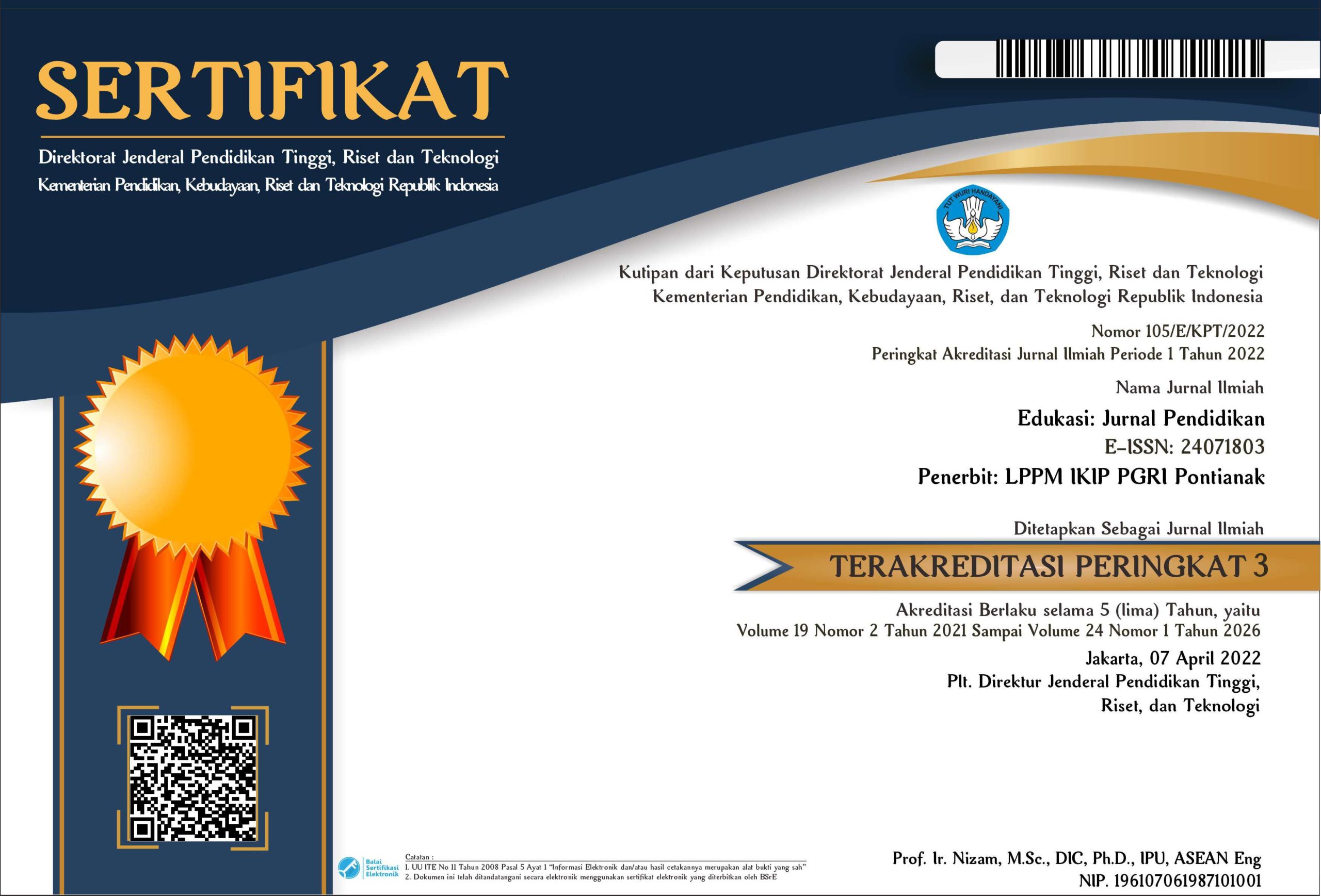Profil Mahasiswa Jurusan Komputer pada Keterampilan Berpikir Kritis dan Kreatif
DOI:
https://doi.org/10.31571/edukasi.v18i2.1939Keywords:
keterampilan berpikir kritis, keterampilan berpikir kreatif, profil mahasiswa, critical thinking skills, creative thinking, students profileAbstract
Abstrak
Penelitian bertujuan untuk mendeskripsikan profil keterampilan berpikir kritis dan kreatif mahasiswa jurusan komputer di Kota Padang. Metode penelitian yang digunakan adalah penelitian deskriptif. Data dikumpulkan melalui kuisioner yang dibuat menggunakan google form kemudian disebarkan kepada responden penelitian yang berjumlah 115 mahaiswa. Teknik analisis data yang digunakan yaitu analisis deskriptif dengan menggunakan persentase per indikator. Hasil penelitian menunjukkan bahwa keterampilan berpikir kritis mahasiswa tergolong rendah pada indikator memberikan penjelasan lebih lanjut dan menarik kesimpulan, serta keterampilan berpikir kreatif untuk berpikir secara lancar dan orisinil mahasiswa masih rendah.
Â
Abstract
The research aimed to describe the critical and creative thinking skills profiles of students majoring in computer in the city of Padang. The research method used descriptive research. Data were collected through a questionnaire made using google form and then distributed to 115 respondents. The data analysis technique used descriptive analysis using percentages per indicator. The results showed that the students' critical thinking skills were low on the indicators of providing further explanation and drawing conclusions, and the students' creative thinking skills to think fluently and originally were still low.
Downloads
References
Adi, S. S. & Junining, E. 2013. Kemampuan Berpikir Kritis dalam Membaca serta Kesesuaiannya dengan Intelegensi Mahasiswa Program Studi Sastra Inggris. Erudio, 2(1): 59-64.
Aizikovitsh-Udi & Cheng. 2015. Mengembangkan Keterampilan Berpikir Kritis dari Disposisi ke Kemampuan: Pendidikan Matematika dari Anak Usia Dini hingga SMA. Kreatif Pendidikan, (6): 455-462.
Ariyatun & Octavianelis, D. F. 2020. Pengaruh Model Problem Based Learning Terintegrasi STEM terhadap Kemampuan Berpikir Kritis Siswa. Journal of Educational Chemistry, 2(1): 33-39.
Arpan, M. & Marpanaji, E. Faktor-Faktor Eksternal yang Memengaruhi Hasil Belajar Pemrograman Komputer Mahasiswa PTIK STKIP PGRI Pontianak. Jurnal Pendidikan Vokasi, 5(2): 195-208.
Aun, S. & Kaewurai, W. 2017. Instructional Model Development to Enhance Critical Thinking and Critical Thinking Teaching Ability of Trainee Students at Regional Teaching Training Center in Takeo Province, Cambodia. Kasetsart Journal of Social Sciences, 38(1): 88–95.
Carrasco, A. 2017. Assessing Creativity to Boost the Inclusion in Musical Education. Artseduca, 16(1): 32-48.
Chu, S. K. W., Reynold, R. B., Tavares, N. J., & Notari, M. 2017. 21st Century Skills Development Through Inquiry-Based Learning from Theory to Practice. Singapore: Springer.
Endang, K. 2012. Kreativitas Siswa dalam Memecahkan Masalah Matematika Divergen Berdasarkan Kemampuan Matematika Siswa. MATHEdunesa, 1(1): 3-11.
Fatmawati, B. 2016. The Analysis of Students Creative Thinking Ability Using Mind Map in Biotechnology Course. Jurnal Pendidikan IPA Indonesia, 5(2): 216-221.
Fitriawan, D., Gordah, E. K., & Dafrita, I. E. 2016. Analisis Korelasi Kemampuan Berpikir Kritis dan Sikap Ilmiah terhadap Prestasi Belajar Mahasiswa. Jurnal Pendidikan Informatika dan Sains, 5(1): 1-11.
Ghanizadeh, A. 2017. The Interplay between Reflective Thinking, Critical Thinking, Self-Monitoring, and Academic Achievement in Higher Education. Higher Education, 74(1): 101-114.
Hairida & Junanto, T. 2018. The Effectiveness using Inquiry Based Natural Science Module with Authentic Assessment to Improve the Critical Thinking. International Journal of Pedagogy and Teacher Education, 2(7): 159-170.
Harris, A. & deBruin, L. R. 2018. Secondary School Creativity, Teacher Practice and STEAM Education: An International Study. Journal of Educational Change, 19(2): 153-179.
Husamah, Fatmawati, D., & Setyawan, D. 2018. OIDDE Learning Model: Improving Higher Order Thinking Skills of Biology Teacher Candidates. International Journal of Instruction, 11(2): 249-264.
Jatmiko, B., Prahani, K., Supardi, Z., Wicaksono, I., Erlina, N., & Pandiangan, P. 2018. The Comparison of OR-IPA Teaching Model and Problem Based Learning Model Effectiveness of Improve Critical Thinking Skills of Pre-Service Physics Teachers. Journal of Baltic Science Education, 17(2): 1-22.
Lin, C., Li, B., & Wu, Y. J. 2018. Existing Knowledge Assets and Disruptive Innovation: The Role of Knowledge Embeddedness and Specificity. Sustainability, 10(342): 1–15.
Lucas, B. 2016. A Five-Dimensional Model of Creativity and Its Assessment in Schools. Applied Measurement in Education, 29(4): 278-290.
Mahanal, S., Zubaidah, S., Bahri, A., & Dinnuriya, M. 2016. Improving Students’ Critical Thinking Skills Through Remap NHT in Biology Classroom. Asia-Pacific Forum on Science Learning and Teaching, 17(1): 1–19.
Munandar, U. 2009. Mengembangkan Bakat dan Kreativitas Anak Sekolah. Jakarta: Gramedia.
Nurhamidah, D., Masykuri, M., & Dwiastuti, S. 2018. Profil Siswa Sekolah Menengah Atas Keterampilan Berpikir Kreatif pada Materi Biologi di Akademik Rendah, Sedang, dan Tinggi Perspektif. Jurnal Fisika: Conf. Seri. Penerbitan TIOPenuntun Bagi Guru dan Orang Tua. Jakarta: Grasindo.
OECD Publishing. 2019. PISA 2018 Insights and Interpretations. PISA: OECD Publishing.
OECD Publishing. 2016. PISA 2015 Result in Focus. PISA: OECD Publishing.
OECD. 2014. PISA 2012 Results: What Students Know and Can Do–Student Performance in Mathematics, Reading and Science. PISA: OECD Publishing.
OECD. 2010. PISA 2009 Results: Learning Trends: Changes in Student Performance Since 2000 (Volume V). PISA: OECD Publishing.
Prahani, B. K., Suprapto, N., Suliyanah, Lestari, N. A., Jauhariyah, M. N. R., & Admoko, S. 2018. The Effectiveness of Collaborative Problem Based Physics Learning (CPBPL) Model to Improve Student’s Selfconfidence on Physics Learning. Journal Physics:Conference Series, 997(08): 1-6.
Rashid, T. & Muhammad, H. 2016. Penggunaan Teknologi, Keterkaitan Komputer dan Perilaku Manusia, Jurnal Teknodik, 19(1): 1-11.
Ridwan. 2010. Dasar-Dasar Statistika. Bandung: Alfabeta.
Septianawati, D. 2019. Kemampuan Berpikir Kreatif Siswa SMP se-Kota Pontianak. Edukasi: Jurnal Pendidikan, 17(1): 38-46.
Seventika, S. Y., Sukestiyarno, Y. L., & Marianti, S. 2018. Critical Thinking Analysis Based on Facione (2015) – Angelo (1995) Logical Mathematics Material of Vocational High School (VHS). Journal of Physics: Conf. Series, 983(2018) 012067: 1-6.
Sing, C. & Kong, C. S. 2017. Professional Learning for 21st Century Education. Journal of Computers in Education, 4(1): 1–4.
Singh, R. M. 2018. Educational Challenges in 21st Century and Sustainable Development. Journal of Sustainable Development Education and Research, 2(1): 9-20.
Sripongwiwat, S., Bunterm, T., Srisawat, N., & Tang, K. N. 2016. The Constructionism and Neurocognitive-Based Teaching Model for Promoting Science Learning Outcomes and Creative Thinking. Asia-Pacific Forum on Science Learning and Teaching, 17(2): 1–33.
Sugiyanto, F. N., Masykuri, M., & M. 2018. Analysis of Senior High School Students’ Creative Thinking Skills Profile in Klaten Regency. IOP Conf. Series: Journal of Physics: Conf. Series 1006 (2018) 012038: 1-5.
Suprapto, N. 2016. What Should Educational Reform in Indonesia Look Like? Learning from the PISA Science Scores of East-Asian Countries and Singapore. Asia-Pacific Forum on Science Learning and Teaching, 17(1): 1–21.
Suyidno, S., Nur, M., Yuanita, L., & Prahani, B. K. 2017. Validity of Creative Responsibility Based Learning: An Innovative Physics Learning to Prepare the Generation of Creative and Responsibility. Journal of Research & Method in Education, 7(1): 56-61.
Taleb & Chadwick. 2016. Enhancing Students Critical Thinking Skill and Analitycal Thinking Skill at the Higher Education Level in Developing Countries:Case Study inDubai. Journal of Education and Instructional Studies in the World, 6 (1): 1-8.
Tan, C. 2017. Teaching Critical Thinking: Cultural Challenges and Strategies in Singapore. British Educational Research Journal, 43(5): 988-1002.
Welter, M. M., Jaarsveld, S., & Lachmann, T. 2017. Problem Space Batters: The Development of Creativity and Intelligence in Primary School Children. Creativity Research Journal, 29(2): 125-132.
Downloads
Published
How to Cite
Issue
Section
License
Authors who publish in this journal agree to the following terms:
- Authors retain copyright and grant the journal the right of first publication with the work simultaneously licensed under a Creative Commons Attribution License (CC-BY-NC) that allows others to share the work with an acknowledgment of the work's authorship and initial publication in this journal.
- Authors are able to enter into separate, additional contractual arrangements for the non-exclusive distribution of the journal's published version of the work (e.g., post it to an institutional repository or publish it in a book), with an acknowledgment of its initial publication in this journal.
- Authors are permitted and encouraged to post their work online (e.g., in institutional repositories or on their website) prior to and during the submission process, as it can lead to productive exchanges, as well as earlier and greater citation of published work.

 Download: 426
Download: 426


















